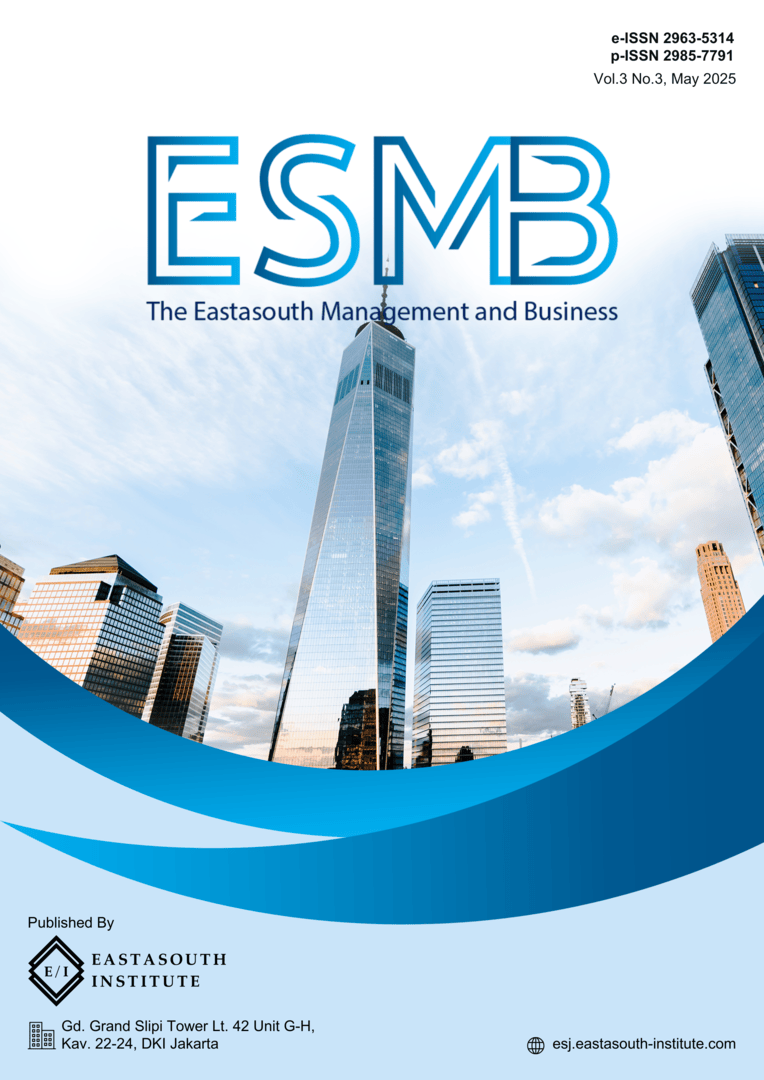Publication Patterns and the Evolution of the Dynamic Capabilities Concept in Global Business Literature
Main Article Content
Abstract
This study examines the evolution, structure, and global dissemination of the dynamic capabilities (DC) concept within business and management literature through a comprehensive bibliometric analysis using VOSviewer. Drawing on data from the Scopus database covering the period 1997–2024, the study maps co-citation relationships, keyword co-occurrence, country collaboration patterns, and thematic trends. The results reveal that Teece, D.J. remains the most influential author, anchoring the field’s theoretical development, while emerging scholars—especially from China and India—are contributing to its expansion. The United States leads international collaboration networks, followed by the United Kingdom and China. Thematic mapping indicates a core cluster focused on innovation, knowledge management, and enterprise resource management, while new clusters highlight intersections with artificial intelligence, machine learning, and sustainability. Temporal analysis shows a shift from system-based approaches toward digitally enabled and strategically integrated research. These findings demonstrate the growing interdisciplinarity, global reach, and strategic relevance of dynamic capabilities, providing valuable insights for scholars and practitioners seeking to navigate organizational adaptation in a rapidly changing business environment.
Article Details

This work is licensed under a Creative Commons Attribution-ShareAlike 4.0 International License.
References
D. J. Teece, G. Pisano, and A. Shuen, “Dynamic capabilities and strategic management,” Strateg. Manag. J., vol. 18, no. 7, pp. 509–533, 1997.
S. A. Zahra, O. Petricevic, and Y. Luo, “Toward an action-based view of dynamic capabilities for international business,” J. Int. Bus. Stud., vol. 53, no. 4, pp. 583–600, 2022.
Z. Samsudin and M. D. Ismail, “The concept of theory of dynamic capabilities in changing environment,” Int. J. Acad. Res. Bus. Soc. Sci., vol. 9, no. 6, pp. 1071–1078, 2019.
S. Choi, I. Cho, S. H. Han, Y. H. Kwak, and Y.-Y. Chih, “Dynamic capabilities of project-based organization in global operations,” J. Manag. Eng., vol. 34, no. 5, p. 4018027, 2018.
C. Prange and S. Verdier, “Dynamic capabilities, internationalization processes and performance,” J. world Bus., vol. 46, no. 1, pp. 126–133, 2011.
J. Weerawardena, G. S. Mort, P. W. Liesch, and G. Knight, “Conceptualizing accelerated internationalization in the born global firm: A dynamic capabilities perspective,” J. world Bus., vol. 42, no. 3, pp. 294–306, 2007.
D. Lessard, D. J. Teece, and S. Leih, “The dynamic capabilities of Meta‐multinationals,” Glob. Strateg. J., vol. 6, no. 3, pp. 211–224, 2016.
N. Donthu, S. Kumar, D. Mukherjee, N. Pandey, and W. M. Lim, “How to conduct a bibliometric analysis: An overview and guidelines,” J. Bus. Res., vol. 133, pp. 285–296, 2021.
C. E. Garcia, D. M. Prett, and M. Morari, “Model predictive control: Theory and practice—A survey,” Automatica, vol. 25, no. 3, pp. 335–348, 1989.
C. E. Helfat and M. A. Peteraf, “The dynamic resource‐based view: Capability lifecycles,” Strateg. Manag. J., vol. 24, no. 10, pp. 997–1010, 2003.
C. L. Wang and P. K. Ahmed, “Dynamic capabilities: A review and research agenda,” Int. J. Manag. Rev., vol. 9, no. 1, pp. 31–51, 2007.
E. Danneels, “The dynamics of product innovation and firm competences,” Strateg. Manag. J., vol. 23, no. 12, pp. 1095–1121, 2002.
I. Barreto, “Dynamic capabilities: A review of past research and an agenda for the future,” J. Manage., vol. 36, no. 1, pp. 256–280, 2010.
B. Wang and K. J. R. Liu, “Advances in cognitive radio networks: A survey,” IEEE J. Sel. Top. Signal Process., vol. 5, no. 1, pp. 5–23, 2010.
D. J. Teece, “The foundations of enterprise performance: Dynamic and ordinary capabilities in an (economic) theory of firms,” Acad. Manag. Perspect., vol. 28, no. 4, pp. 328–352, 2014.
C. E. Helfat and M. A. Peteraf, “Managerial cognitive capabilities and the microfoundations of dynamic capabilities,” Strateg. Manag. J., vol. 36, no. 6, pp. 831–850, 2015.
B. Demil and X. Lecocq, “Business model evolution: in search of dynamic consistency,” Long Range Plann., vol. 43, no. 2–3, pp. 227–246, 2010.
D. J. Teece, “Business models and dynamic capabilities,” Long Range Plann., vol. 51, no. 1, pp. 40–49, 2018.
D. J. Teece, “Explicating dynamic capabilities: the nature and microfoundations of (sustainable) enterprise performance,” Strateg. Manag. J., vol. 28, no. 13, pp. 1319–1350, 2007.
C. N. Pitelis, D. J. Teece, and H. Yang, “Dynamic capabilities and MNE global strategy: A systematic literature review‐based novel conceptual framework,” J. Manag. Stud., vol. 61, no. 7, pp. 3295–3326, 2024.

